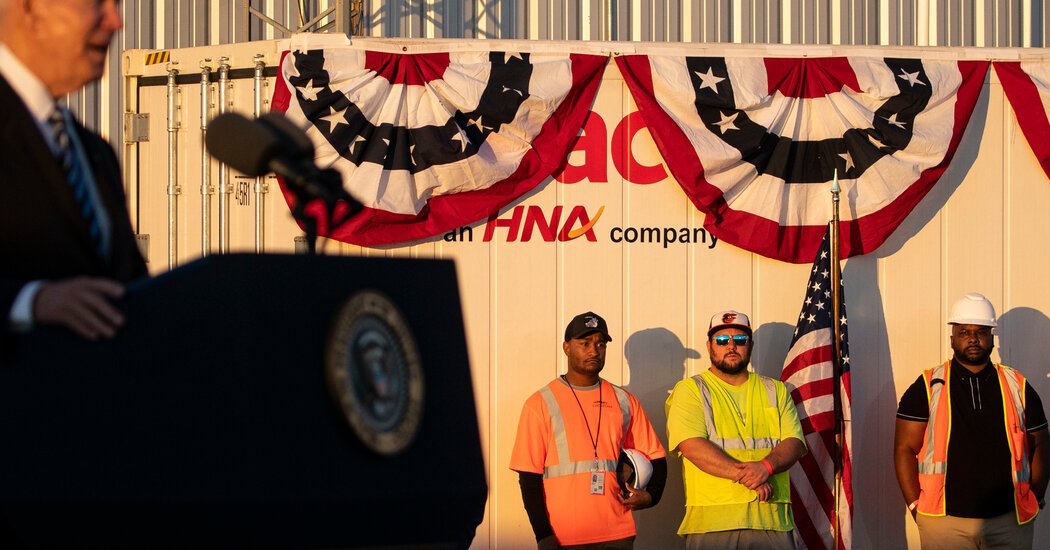About 60 percent of U.S. voters do not have a four-year college degree, and they live disproportionately in swing states. As a result, these voters — often described as the American working class — are crucial to winning elections. Yet many of them are deeply skeptical of today’s Democratic Party.
Republicans retook control of the House last year by winning most districts with below-median incomes. In nearly 20 Western and Southern states, Democrats are virtually shut out of statewide offices largely because of their weakness among the white working class. Since 2018, the party has also lost ground with Black, Asian and especially Latino voters.
Unless the party improves its standing with blue-collar voters, “there’s no way for progressive Democrats to advance their agenda in the Senate,” according to a study that the Center for Working-Class Politics, a left-leaning research group, released this morning.
The class inversion of American politics — with most professionals supporting Democrats and more working-class people backing Republicans — is one of the most consequential developments in American life (and, as regular readers know, a continuing theme of this newsletter).
Today, I’ll be writing about what Democrats might do about the problem, focusing on a new YouGov poll, conducted as part of the Center for Working-Class Politics study. In an upcoming newsletter, I’ll examine the issue from a conservative perspective and specifically how Republicans might alter their economic agenda to better serve their new working-class base.
A key point is that even modest shifts in the working-class vote can decide elections. If President Biden wins 50 percent of the non-college vote next year, he will almost certainly be re-elected. If he wins only 45 percent, he will probably lose.
‘Fight for us all’
Elections can be tricky for social scientists to study. The sample sizes are small and idiosyncratic. Researchers can’t conduct hundreds of elections in a laboratory, changing one variable at a time and analyzing how the results change. But researchers can conduct polls that pit hypothetical candidates against each other and see how the results change when the candidates’ biographies, messages and policy proposals change.
This approach, which has become more common among pollsters, is the one that YouGov used. It focused on swing voters — those who don’t identify strongly with either party, many of whom are working class. The poll described a pair of Democratic candidates, each with a biography and a campaign platform, and asked respondents which one they preferred.
Among the findings:
-
Voters preferred a candidate who was a teacher, construction worker, warehouse worker, doctor or nurse. The least popular candidate professions were lawyer and corporate executive.
-
Many effective messages involved jobs, including both moderate policies (like tax credits for training at small businesses) and progressive ones (like a federal jobs guarantee). “People are obviously interested in good-paying jobs,” said Bhaskar Sunkara, the founder of Jacobin, a leftist magazine that helped sponsor the project. “They have an identity that’s rooted in their work.”
-
Black and Latino candidates were slightly more popular than other candidates, mostly because some voters of color preferred candidates of color. (Related: Black candidates — of different ideologies — have beaten non-Black candidates in recent mayoral primaries and elections in Chicago, Los Angeles, New York and Philadelphia, Matthew Yglesias of Substack pointed out to me.) But candidate messages that explicitly mentioned race were unpopular.
-
Voters liked Democrats who criticized both political parties as “out of touch.” There is real-world evidence to support this finding, too: Senator Mark Kelly of Arizona and Representative Marcy Kaptur of Ohio won close races last year while highlighting their differences with Democratic leaders, as Data for Progress, another research group, has noted.
-
Moderate social policies fared better than more liberal ones. The single most effective message in the poll was a vow to “protect the border”; decriminalization of the border was very unpopular.
-
Swing voters liked tough, populist messages such as “Americans who work for a living are being betrayed by superrich elites” and “Americans need to come together and elect leaders who will fight for us all.” As Jared Abbott, the director of the Center for Working-Class Politics, argued, “Democrats need to be less concerned with rhetorical niceties.” Doing so would hardly be new: Harry Truman and Franklin Roosevelt used such red-blooded language.
The bottom line
I find the study’s conclusions fascinating because they are both original and consistent with other evidence. Democrats who have won difficult recent elections, including both progressives and moderates, have often presented a blue-collar image.
President Biden talks about growing up in a working-class neighborhood. Marie Gluesenkamp Pérez, who owns a car-repair shop, flipped a House district in Washington State partly by criticizing her own party for being elitist. Senator Sherrod Brown, the only Democrat to win statewide in Ohio since 2011, is a populist. So is John Fetterman of Pennsylvania, the only Senate candidate from either party to flip a seat last year.
Many Americans are frustrated with the country’s direction, and they want candidates who will promise to fight for their interests. One of the vulnerabilities of today’s Democratic Party, as my colleague Nate Cohn has written, is that it has come to be associated with the establishment.
More on politics
THE LATEST NEWS
Trump Indictment
Mr. Beast: His headline-grabbing giveaways made him the Willy Wonka of YouTube. Why do people think he’s evil?
Health: Sleep is more challenging for women than for men.
Lives Lived: Treat Williams, famous for his roles in the movies “Hair” and “Deep Rising” and the TV show “Everwood,” died at 71.
SPORTS NEWS FROM THE ATHLETIC
N.B.A. finals: The Denver Nuggets beat the Miami Heat to win their first championship. Nikola Jokic cemented his spot in the pantheon of N.B.A. greats with a stunning performance.
A departure: The Oklahoma softball ace Jordy Bahl said she would leave the program.
A mission: Christian McCaffrey’s voice was the last thing Logan Hale heard. Now McCaffrey, a 49ers running back, is helping fulfill his young fan’s final wish.
ARTS AND IDEAS
An ancient reunion: It’s not a coincidence that so many of the statues in museums are missing their heads: Throughout history, invaders would target statues when they attacked a city, decapitating the likenesses of local leaders to make a statement. And the statues that survived were often chopped up by smugglers, who wanted two artifacts to sell instead of one. Now, as Graham Bowley writes in The Times, those ancient acts of vandalism have made it hard for museums to match heads with their long-lost torsos.





